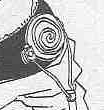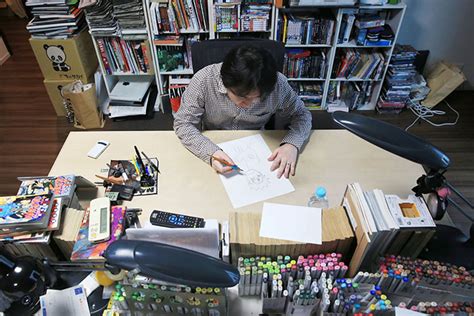Guide Contents
In 2006, Shonen Jump (US) conducted an interview with the creator of the Naruto manga series, Masashi Kishimoto.
Shonen Jump: Let’s get right to the most pressing and important question, something our readers often ask, and we’d like to know, too: What is this thing?

- Masashi Kishimoto: Many Japanese fans ask the same question. What is it? I just drew it in as a spur-of-the-moment thing, and it doesn’t have much meaning. I’m hoping I can expand more on it later and integrate it into the story.
Shonen Jump: Are any of the characters we’ve met based on people you know or experiences you’ve had?
- Masashi Kishimoto: I did base some of the characters on my friends in college, with some embellishments. But really, I’ve been creating original characters mostly.
Shonen Jump: Sakura and Rock Lee don’t appear to have any of the special powers that ninja like Naruto, Sasuke, or Gaara have—do you think those two characters are popular because they provide a kind of reader’s-eye view of the story as it unfolds?
- Masashi Kishimoto: Is Sakura popular in the U.S.? Well, Lee only has Taijutsu. And as a girl, Sakura is physically weaker than the others. So I can see why it’s easy to empathize with them. They represent human weaknesses.
Shonen Jump: We want to know more about the rest of the Naruto world—what are the normal people like, what are the governments like, is this the whole world?
- Masashi Kishimoto: The world outside of the ninja is pretty normal. People make their living by running businesses, et cetera. Konohagakure, the Village Hidden in the Leaves, is the military part of the country. Hinokuni, or the Land of the Fire, provides Konohagakure a place to live, and in return, the resident ninja protect the country as a whole, similar to a military force.
- As for the government, the daimyo, or warlords, govern the lands and run the political system and the bureaucracy.
- Each country has warlords at the top, and its military has its own leaders. In America, you have a president at the top, but you also have the military general at the top of the military. The states have more power than the ninja, but since the daimyo don’t cooperate with each other, I guess coup d’etats happen rather frequently. The world is not yet solid [laughs], but what you see in the story is not everything in the world of Naruto.
Shonen Jump: Has it been tough to maintain the rigorous production needs of the manga, now that you have a family? Do you ever get used to the intense schedule?
- Masashi Kishimoto: It’s been six years since I’ve started Naruto, but I’ve never gotten used to the schedule of weekly installments. The lifestyle is not for any normal human. When I was just a reader of manga, I always thought “Why can’t the artists draw more?” Now that I’ve finally became a manga-ka, I’m like “You’re asking for something impossible!” [laughs]
Shonen Jump: Have any of your assistant artists gone on to do their own manga yet?
- Masashi Kishimoto: Yes, one of them has: Osamu Kajisa. His work, Tatoo Hearts, has been published.
Shonen Jump: It sounds like you had a pretty happy childhood—what motivated you to write a story about an outsider?
- Masashi Kishimoto: My childhood wasn’t all that happy. It may have sounded like it was all good in my journal entries in the manga volumes, but that was in order to make it interesting for the readers. Like any person, I’ve had hardships in my life. I was not the center of anyone’s attention in school, rather sitting on the outskirts. I didn’t do well in everything. I didn’t excel in studies nor sports. So I can understand Naruto’s feelings of being an underdog. I don’t really like people who are too perfect. [laughs]
Shonen Jump: Oda-sensei says he knows how One Piece will end—do you know how Naruto will end?
- Masashi Kishimoto: Yes, I have the last episode clearly drawn in my mind. I’ve already decided on the layout, text, and scenes. Not just the story ideas, but the visual ideas are solid.
- All I have to do is just head toward the ending I have, but there are still so many things that need to be resolved before reaching that point. Maybe I have thrown in too many ideas, so I need to wrap them up neatly.
Shonen Jump: Do you keep up with baseball, or any other American sports?
- Masashi Kishimoto: American sports? Well, since there’s an American football manga, Eyeshield 21, serialized in Weekly Shonen Jump, I sometimes watch football games on TV. And there’s basketball… but in the end, I think baseball is my favorite, since I used to play the sport. I could have never imagined that Japanese players would make it to the ranks of the Major Leagues.
Shonen Jump: Has there been anything you’ve wanted to do in the manga you haven’t put in yet?
- Masashi Kishimoto: As ideas come to me, I try to include them. With the volumes of Naruto manga I’ve put out so far, I’ve already done most of the things I wanted to do. So now I’m trying to figure out what to do next. Well, I haven’t really written about romantic relationships…
Shonen Jump: How do you manage to keep coming up with exciting ideas for fights and stories?
- Masashi Kishimoto: I do it by listening to music that fits the scenes I’m drawing.
Shonen Jump: What kind of music?
- Masashi Kishimoto: I listen to all genres, both Japanese and Western- as in non-Japanese- especially movie soundtracks and game music.
Shonen Jump: What do you like most about Jump Festa?
- Masashi Kishimoto: I get to meet the readers and find out what they are actually like. It’s a nice change of scenery, since I’m usually confined in my room drawing manga.
Shonen Jump: Do you actually get to feel the popularity of your work at Jump Festa?
- Masashi Kishimoto: No… it doesn’t feel all that real to me.
Shonen Jump: We’re just starting to get the Naruto video games in the U.S.- could you tell us which Naruto video game was your favorite, and why?
- Masashi Kishimoto: I play all those games at least once. I like the ones that have fighting.
Shonen Jump: Do you play other games?
- Masashi Kishimoto: Yes, I play different kinds of games on different platforms. I have them all: Nintendo, Sega, and Sony. And Xbox.
Shonen Jump: Are you afraid of snakes?
- Masashi Kishimoto: Yes, I’m not fond of them. I like the details of the skin, but not the snake itself.
Shonen Jump: Do you have any messages for the American fans?
- Masashi Kishimoto: America is vast in its land and its audience. The sense of entertainment is outstanding, incomparable to any other country. France, of course, is known for people with taste, but when it comes to entertainment and showmanship there’s nothing like Hollywood. Disney especially has technologies that are second to none. So I’m very glad that my work is accepted by an audience with such discerning eyes.
Masashi Kishimoto agreed to answer these questions in the voice of Kakashi, mentor to Naruto, Sasuke, and Sakura.
Shonen Jump: How have your three students surprised you thus far?
- Kakashi: Surprised? I’m very calculating, so I’m not that easy to “surprise.” *laughs* However… Naruto is very active and does whatever he wants to do. But surprisingly, he always does his best. He is a hard worker. Sasuke is an elite ninja, sure, but he turns out to be not all that useful – he’s rather sloppy. So rather than being surprised, I’m disappointed. Sakura is easily excited but has a good memory.
Shonen Jump: Which is stronger: sand or sound?
- Kakashi: Hmm, in the end, I think Sound prevails.
Shonen Jump: Which of your three students would make the best ninja instructor?
- Kakashi: I think it would be Sakura. She has flaws in her personality, like stalking Sasuke. But Sakura is the closest to being normal. Naruto is stupid, and Sasuke is not a teacher-type. He keeps to himself.
Shonen Jump: What’s the worst thing your teacher did to you when you were training to be a ninja? [Kishimoto-sensei spent a long time pondering this, showing us how difficult the question is for Kakashi.]
- Kakashi: I was an excellent student, so I never suffered.

